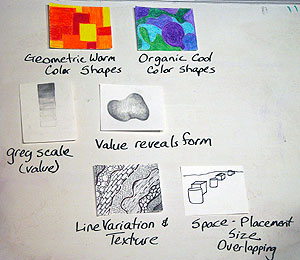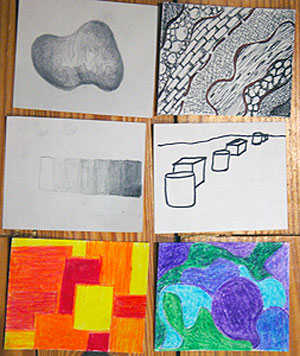Fourth Grade Art Lesson 5
Elements of Art, Part 4 Creating Space and Reviewing the 7 Elements
Objective:
The student will use size, placement and overlapping to show distance. The student will look at all of the art element cards we have made, label each of them and review the information we have learned.
Materials:
another card or paper like the ones we have been using, any marking tool (i.e. pencil, ink pen, crayon), all of your elements of art study cards
Procedure:
The last element of art I want us to look at today is space. We discussed space in our warm/cool /shape study but today I want us to look at space in terms of distance. There are three things you can do on a flat surface to show distance: 1. placement 2. size 3. overlapping. Theses three things simply mean that when you want objects to appear closer, they should be drawn large and toward the bottom of your paper (or canvas) and as they get farther away, they should be placed higher up on the paper and drawn smaller. We have already seen that overlapping creates distance, although it was a shallow space when we put one shape in front of the other. Overlapping is a great technique because it means you do not have to draw the entire object that goes behind the others. On your card or paper, I want you to show distance using these three concepts. Take any form and sit it low on your paper and draw it large. As you move up the page, draw the same form smaller and smaller until it looks like it is far away. To really emphasize the distance, draw a line above the form that is highest on your page to create the illusion of a horizon line (where the earth and the sky meet). Spend time working with the idea of creating space and practice it so you can master the art of creating the illusion of distance on a two dimensional surface.
Next I want us to look at all of our elements of art works. Lay them out for review. First let's look at our color, shape and space drawings. Turn each of these over and write on the back what you used. For example, warm, geometric overlapping shapes. List any information you have learned about warm or cool colors, the two types of shapes and how you overlap. Also you might list the material or medium you used (in this case it would be crayon). Next look at your shape and form work. Write on the back grey scale of the one that is your grey scale along with the word value to remind you that the art element value is about the range of lightness and darkness of a color or grays. On the drawing of your form write value reveals form. You might also note that form is a three dimensional object as opposed to a shape, which is two dimensional. On your line and texture drawing, write on the back line variation and explain what that means and define texture as the quality of a surface. Finally, on the back of the card we did today, list the three ways to show space, placement, size and overlapping and write that these pertain to the art element space.
Conclusion:
Understanding these seven elements of art will significantly help to improve the quality of your work. If you look at any of the writing you did in kindergarten, you might notice that the information was not exactly accurate, and of course it is because you did not understand the alphabet completely. Likewise, as you grow to understand the information we have reviewed today your work will improve and become for controlled and deliberate. You will find that you are able to represent the things you want to represent the way you want. Keep you elements cards to refer to throughout the year as reminders of the art elements and we will progress by working on them more fully throughout our class this year.
Artwork and Examples used in this lesson

Teacher Example

Teacher Example













